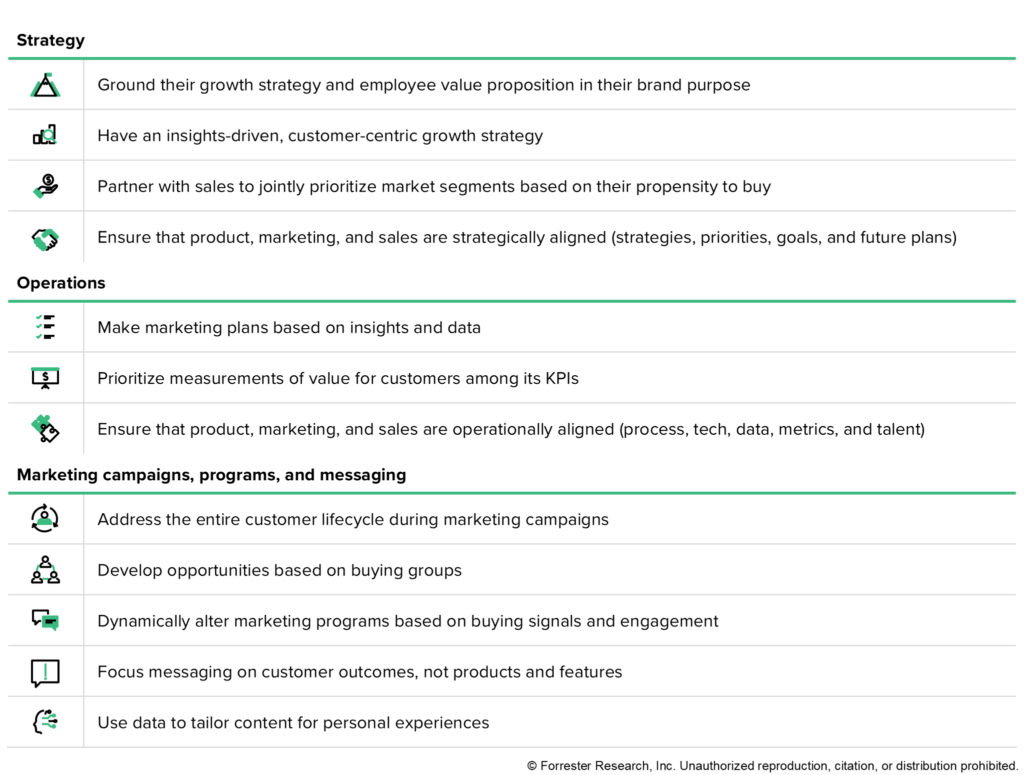What Sets Leading B2B Marketers Apart?
Forrester’s Marketing Survey, 2025, reveals a sharp divide between leading and lagging B2B marketers and their organizations. Based on responses from 1,060 marketing decision-makers, Forrester identified a cohort of “leading marketers” who consistently apply 12 best practices — from cross-functional collaboration to customer-centric strategies (see the figure below) — and a cohort of “lagging marketers” who fall short in these areas. The business impact is clear: Leading marketers report that their organizations see significantly stronger revenue and profit.

Growth That Matters
Leading marketers’ businesses achieved an average annual revenue growth of 11%, compared to under 1% for the laggards’ businesses. Nearly all of the leading marketers’ businesses saw positive growth, with the overwhelming majority reporting growth of 5% or more. Profit growth follows a similar pattern, with leading marketers’ companies growing profit more than two times faster than laggards. These results likely stem from the adoption of marketing practices that emphasize customer value, lifecycle engagement, and both strategic and operational alignment with sales and product teams.
Productivity Over Market Expansion
Rather than chasing new markets, leading marketers’ organizations focus on productivity-driven growth. They also anchor their strategies in customer insights and brand promises, emphasizing customer outcomes over features. This approach leads to more efficient buyer engagement and both stronger customer retention and expansion. Leading marketers’ companies have revenue composition that favors existing customers.
AI Adoption: Another Clear Differentiator
AI readiness is another defining trait. Leading marketers are more likely to have operationalized AI/ML in production across one or more of 14 out of 15 use cases we tracked, including personalization, content recommendation, and intent monitoring. Likewise, genAI adoption is notably higher, with 38% of leading marketers using it in production versus 14% of lagging marketers. While lagging marketers cite employee readiness as a barrier, leaders express more advanced challenges related to integration, governance, and data privacy that surface with deeper usage.
The Power Of Technology Partnership
Compared to laggards, B2B marketing leaders invest more in technology, but unlike their laggard peers, they don’t try to go it alone. Over two-thirds of B2B marketing leaders report that their organization leverages dedicated or hybrid IT-marketing teams, enabling more agile and scalable tech adoption. Strong interdepartmental processes and communication are key to their success — especially as AI becomes central to marketing strategy.
What It Means
Forrester’s findings underscore that leading marketers are applying best practices to build smarter, more connected growth engines. Their focus on customer outcomes, strategic alignment, and AI-driven efficiency positions them to outperform in a rapidly evolving B2B landscape.
Forrester clients can read more in the full report and schedule an inquiry or guidance session to further explore the findings and what they mean for your organization.
